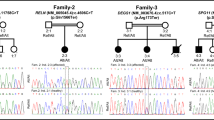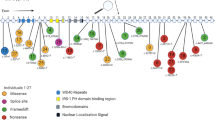Abstract
The congenital muscular dystrophies (CMD) are a heterogeneous group of autosomal recessive disorders, which present within the first 6 months of life with hypotonia, muscle weakness and contractures, associated with dystrophic changes on skeletal muscle biopsy. We have previously reported a large consanguineous family segregating merosin-positive congenital muscular dystrophy, in which involvement of known CMD loci was excluded. A genome-wide linkage search of the family conducted using microsatellite markers spaced at 10-Mb intervals failed to identify a disease locus. A second scan using a high-density SNP array, however, permitted a novel CMD locus on 4p16.3 to be identified (multipoint LOD score 3.4). Four additional consanguineous CMD families with a similar phenotype were evaluated for linkage to a 4.14-Mb interval on 4p16.3; however, none showed any evidence of linkage to the region. Our findings further illustrate the utility of highly informative SNP arrays compared with standard panels of microsatellite markers for the mapping of recessive disease loci.

Similar content being viewed by others
References
Beltran-Valero de Bernabe D, Currier S, Steinbrecher A, Celli J et al (2002) Mutations in the O-mannosyltransferase gene POMT1 give rise to the severe neuronal migration disorder Walker–Warburg syndrome. Am J Hum Genet 71:1033–1043
Brockington M, Sewry CA, Herrmann R, Naom I et al (2000) Assignment of a form of congenital muscular dystrophy with secondary merosin deficiency to chromosome 1q42. Am J Hum Genet 66:428–435
Brockington M, Blake DJ, Prandini P, Brown SC et al (2001) Mutations in the fukutin-related protein gene (FKRP) cause a form of congenital muscular dystrophy with secondary laminin alpha2 deficiency and abnormal glycosylation of alpha-dystroglycan. Am J Hum Genet 69:1198–1209
Camacho VO, Bertini E, Zhang RZ, Petrini S et al (2001) Ullrich scleroatonic muscular dystrophy is caused by recessive mutations in collagen type VI. Proc Natl Acad Sci USA 98:7516–7521
Collins C, Schappert K, Hayden MR (1992) The genomic organisation of a novel regulatory myosin light chain gene (MYL5) that maps to chromosome 4p16.3 and shows different patterns of expression between primates. Hum Mol Gen 1:727–733
Demir E, Sabatelli P, Allamand V, Ferreiro A et al (2002) Mutations in COL6A3 cause severe and mild phenotypes of Ullrich congenital muscular dystrophy. Am J Hum Genet 70:1446–1458
Dubowitz V (1994) 22nd ENMC sponsored workshop on congenital muscular dystrophy held in Baarn, The Netherlands, 14–16 May 1993. Neuromuscul Disord 4:75–81
Helbling-Leclerc A, Zhang X, Topaloglu H, Cruaud C et al (1995) Mutations in the laminin alpha 2-chain gene (LAMA2) cause merosin-deficient congenital muscular dystrophy. Nat Genet 11:216–218
Higuchi I, Shiraishi T, Hashiguchi T, Suehara M et al (2001) Frameshift mutation in the collagen VI gene causes Ullrich’s disease. Ann Neurol 50:261–265
Kobayashi K, Nakahori Y, Miyake M, Matsumura K et al (1998) An ancient retrotransposal insertion causes Fukuyama-type congenital muscular dystrophy. Nature 394:388–392
Kruglyak L, Daly MJ, Lander ES (1995) Rapid multipoint linkage analysis of recessive traits in nuclear families, including homozygosity mapping. Am J Hum Genet 56:519–527
Lampe A, Dunn DM, von Niederhauserm AC, Hamil C et al (2005) Automated genomic sequence analysis of the three collagen VI genes: applications to Ullrich congenital muscular dystrophy and Bethlem myopathy. J Med Gen 42:108–120
Longman C, Brockington M, Torelli S, Jimenez-Mallebrera C et al (2003) Mutations in the human LARGE gene cause MDC1D, a novel form of congenital muscular dystrophy with severe mental retardation and abnormal glycosylation of alpha-dystroglycan. Hum Mol Genet 12:2853–2861
Mahjneh I, Vannelli G, Bushby K, Marconi GP (1992) A large inbred Palestinian family with two forms of muscular dystrophy. Neuromuscul Disord 2:277–283
Mahjneh I, Bushby K, Anderson L, Muntoni F et al (1999) Merosin-positive congenital muscular dystrophy: a large inbred family. Neuropediatrics 30:22–28
Manda R, Kohno T, Matsuno Y, Takenoshita S et al (1999) Identification of genes (SPON2 and C20orf2) differentially expressed between cancerous and noncancerous lung cells by mRNA differential display. Genomics 61:5–14
Matsuzaki H, Loi H, Dong S, Tsai YY et al (2004) Parallel genotyping of over 10,000 SNPs using a one-primer assay on a high-density oligonucleotide array. Genome Res 14:414–425
Moghadaszadeh B, Petit N, Jaillard C, Brockington M et al (2001) Mutations in SEPN1 cause congenital muscular dystrophy with spinal rigidity and restrictive respiratory syndrome. Nat Genet 29:17–18
Muntoni F, Voit T (2004) The congenital muscular dystrophies in 2004: a century of exciting progress. Neuromuscul Disord 14:635–649
Poetter K, Jiang H, Hassanzadeh S, Master et al (1996) Mutations in either the essential or regulatory light chains of myosin are associated with a rare myopathy in human heart and skeletal muscle. Nat Genet 13:63–69
Sellick GS, Longman C, Tolmie J, Newbury-Ecob R et al (2004) Genome-wide linkage searches for Mendelian disease loci can be efficiently conducted using high-density SNP genotyping arrays. Nucleic Acids Res 32:e164
Yoshida A, Kobayashi K, Manya H, Taniguchi K et al (2001) Muscular dystrophy and neuronal migration disorder caused by mutations in a glycosyltransferase, POMGnT1. Dev Cell 1:717–724
Acknowledgments
The authors wish to thank the families and their physicians for their co-operation. Gabrielle Sellick was in receipt of a Postdoctoral Research Fellowship from Leukaemia Research. A grant from the Muscular Dystrophy Campaign to F.M. is gratefully acknowledged. Conflict of interest: none declared.
Author information
Authors and Affiliations
Corresponding author
Rights and permissions
About this article
Cite this article
Sellick, G.S., Longman, C., Brockington, M. et al. Localisation of merosin-positive congenital muscular dystrophy to chromosome 4p16.3. Hum Genet 117, 207–212 (2005). https://doi.org/10.1007/s00439-005-1301-4
Received:
Accepted:
Published:
Issue Date:
DOI: https://doi.org/10.1007/s00439-005-1301-4




